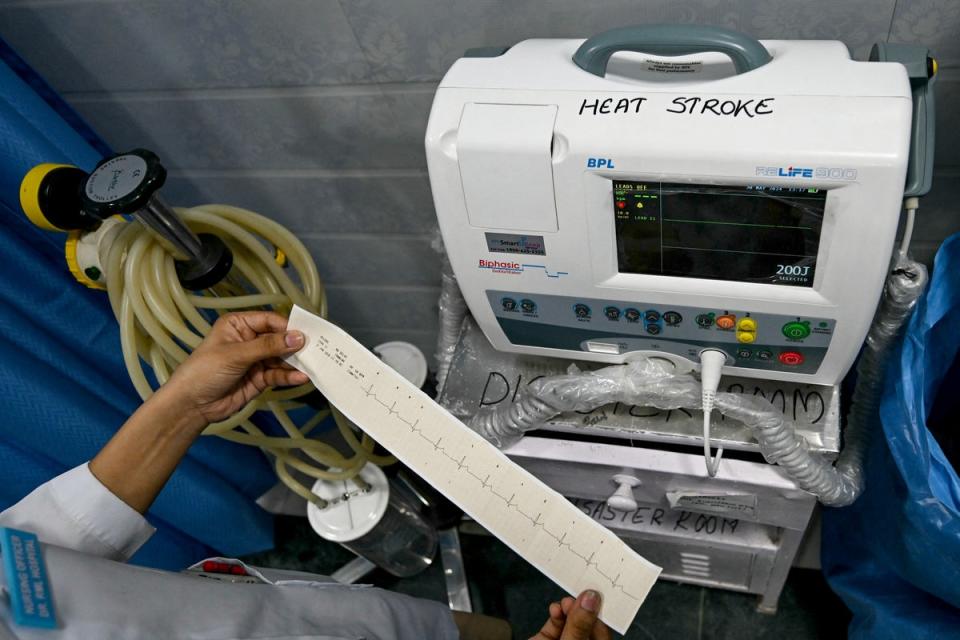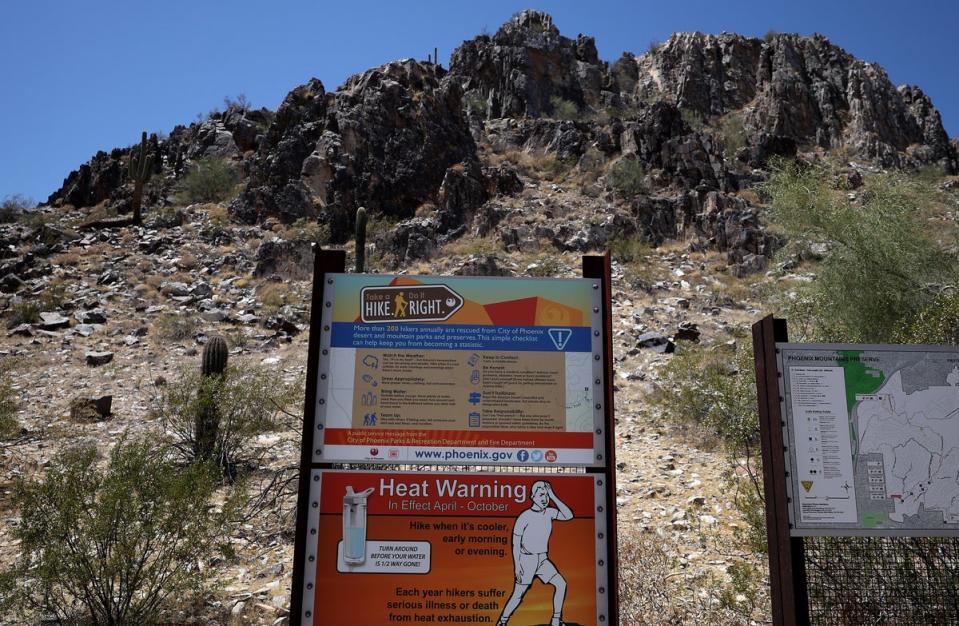The horrors of hot weather: How the body dies from heat

The heat dome is upon us — and your first warning sign of heat stroke might be flagged by your watch.
This week, much of the central and eastern US is under an oppressive atmospheric event that traps heat and causes extreme heat waves.
At least 270 million people experienced extreme temperatures this week. Chicago, Illinois broke a 1957 temperature record on Monday with a high of 97F (36C), while Hartford, Connecticut beat a 1995 record on Wednesday by two degrees as the city also hit 97F. New York City saw its first heat wave since September 2023, with the heat index — that is, what temperature it feels like to people — reaching into the triple digits. These can be deadly events even for seemingly healthy low-risk people, medical and environmental experts tell The Independent.
Last year 2,302 people in the US died from a heat-related illness, the highest ever number in 45 years of record keeping. Here’s what happens when bodies overheat — and what we can do to prevent it.

How an overheated body starts shutting down
When heat-related illness begins, one of the first signs is a rapid heart rate, according to Dr Roxana Chicas, a nurse and assistant professor at Emory University.
Then, if that lasts long enough, you stop sweating as your body redirects all blood to its vital organs — making the body overheat even more, according to Chicas. Before long, the nervous system begins to break down as proteins in the body begin to unravel, according to Dr Lewis Halsey, a professor of life and health sciences at London’s University of Roehampton.
You’ll feel thirsty — dehydration often plays a key role in heat-related illness. As water leaves the body, cells begin to shrink, Halsey explained, and communication between cells breaks down.
While all these systems experience a breakdown, the body is working its hardest to protect the brain — but once that vital organ overheats, several experts explained, disorientation and other neurological symptoms begin to set in.
That means you might start feeling confused, struggle to remember things or say things that don’t quite make sense.

These symptoms can come for you even if you’re a young, healthy fit person with no previous illnesses, under enough heat stress. But, if caught soon enough, heat-related illness is not a death sentence — it’s a warning, according to Alejandro Saez Reale, a member of the technical support unit for the Global Heat Health Information Network.
“It’s a medical emergency against time,” Saez Reale told The Independent. “You have 30 minutes to reduce the body temperature after heat stroke — if not, the survival rate without medical intervention is one out of five.”
Emergency interventions for adults can involve simple tasks like taking them to a cooler place and giving them cold water, according to Chicas. More extreme interventions that medical professionals use include placing ice on the neck and under their armpits, as well as starting hydration through an IV, Chicas said.
Dr Lisa Harshad Patel, a practicing pediatrician with a background in environmental science, said interventions for children involve similar strategies, like hydration and placing cool towels on them.
Infants can be especially prone to heat-related illness, Patel said, because they cannot tell everybody that they’re feeling hot.
Plus, infants also have more difficulty regulating their body temperature and depend entirely on the adults around them, Patel said, making them even more vulnerable. But the methods for cooling them down are the same as for big kids.
Believe you are not at risk for heat-related illness? Think again
While heatwaves are dangerous for everyone, certain groups are at higher risk for heat-related illness, including the elderly, those without air conditioning, the unhoused and outdoor workers. However, experts tell The Independent, there are several overlooked populations who are at high risk too.
For example: Patients taking selective serotonin reuptake inhibitors (SSRIs) and non-steroidal anti-inflammatory drugs (NSAIDs) — both common types of medication, including standard antidepressants and ibuprofen — are at higher risk of heat stroke. These medications make patients vulnerable because they can have dehydrating effects, according to Dr Laura Kwong, assistant professor of environmental health sciences at the University of California, Berkeley.
Pregnant people and their fetuses are also at higher risk for heat-related illness — with pregnant people usually running hot anyway due to the extra blood pumping through them. Extreme heat increases the chances of birth complications, said Patel, while Halsey noted that pregnant people are more susceptible to heat stroke.

“I’ll tell you the last few shifts I’ve worked, when we’ve had a few days of continued heat, our [neonatal intensive care unit] has tended to fill up,” Patel said.
Patel also pointed to incarcerated people as an overlooked population because they rely on wardens for safety and are trapped if air conditioning breaks or is absent from their facility.
Perhaps surprisingly, anyone who lives in a colder area will be more susceptible to heat-related illness because their bodies have not had time to acclimate when the heat suddenly hits, experts told The Independent. This risk factor will only become more prevalent as the climate crisis drives heat waves in colder regions.
But one of the highest risk groups, Kwong said, is older men who live alone. She suspects it’s because they are less likely to ask for help — although there isn’t specific data to show that.
“If you know someone living alone, especially if they’re elderly or they have respiratory or cardiovascular disease, or if they have a disability that impairs their movement or cognitive ability, take time,” Kwong continued. “Give them a call. Ask how they’re feeling, ask how they’re keeping cool.”
Ultimately, experts said, no one is immune to heat stroke — but being aware of those at the highest risk is essential to preventing heat-related deaths.
“All heat deaths are absolutely preventable,” Saez Reale said.
How we can save ourselves — and others
A whopping 6.3 billion people worldwide experienced at least 31 days of extreme heat since mid-2023. As the climate crisis drives more extreme and frequent heatwaves in the US and around the world, experts say 2024 will likely be the hottest year on record at a global level following the record-setting 2023.
There are personal and community-level actions we can take to prevent heat-related deaths but several experts tell The Independent the ultimate solution is stopping the human-driven climate crisis in its tracks.
Community members can help themselves and others by staying hydrated, avoiding exercise, and checking in on vulnerable people.
Multiple experts said employers and policymakers also have a duty to implement regulations that protect all workers from heat-related illness.
Patel, who also serves as commissioner for the National Commission on Climate and Workforce Health, says both indoor and outdoor workers are susceptible to heat-related illness, specifically noting that those who work in warehouses, delivery trucks or any facility without reliable air conditioning are in danger.
These dangers are exacerbated by the lack of nationwide heat protection regulations from the Occupational Safety and Health Administration (OSHA), meaning there are no guidelines on people requiring breaks, air-conditioning or other contingencies due to heat. “OSHA has been trying to work on a heat standard for years, but large industrial lobbies have come out against it and try to gum it up, because they are saying they don’t want more regulations,” Patel said.
Saez Reale noted that some progress is being made on a state-by-state basis. In April, Arizona appointed Eugene Livar as the nation’s first-ever Chief Heat Officer, who will implement heat preparedness strategies and coordinate communication during a heat crisis.

However, other states are going in the wrong direction. Earlier this year, Florida Governor Ron DeSantis signed into law a bill banning local governments from enacting heat protections for workers.
Ultimately, several experts said, the most important solution is to stop the climate crisis in its tracks.
In 2023, global warming exceeded 1.5C — the upper limit set by the Paris Agreement to stave off the most harmful consequences of the climate crisis — across an entire year for the first time. Then, in November, Earth breached the milestone temperature of 2C for the first time. While temporary, experts warned the breach is a dire sign.
“We’re talking about vast parts of this country that are going to be experiencing this type of weather that is going to result in death and in harm,” Patel said.


